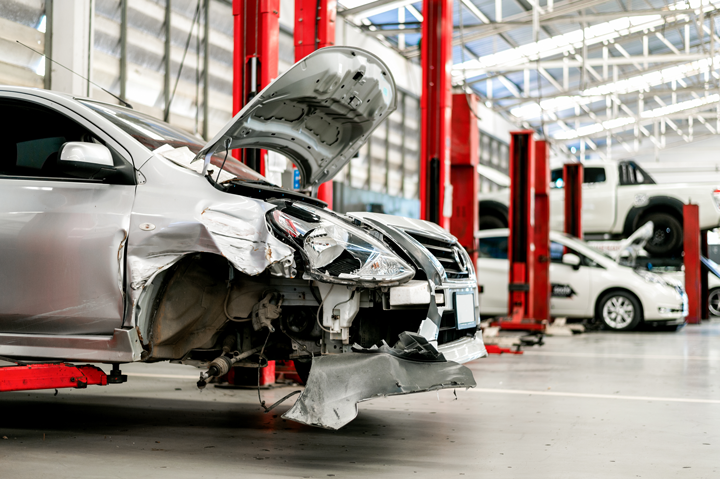Can Car Frame Damage Be Repaired?
Frame damage is often the result of a serious accident and can be costly to repair. In the worst cases, it can compromise the structural integrity of a vehicle, leading to a total loss. Frame damage can also cause safety hazards for you or others on the road if they’re left unrepaired. If you suspect your car has suffered frame damage, it’s important to learn what it means and what you can do to fix it.
Need to get your car back on the road after an accident?
Contact Flagstaff Collision Center for our collision repair services!
What Is Frame Damage?
A car’s frame is like a skeleton, providing structural support and helping to align the wheels, hold the suspension, support the radiator, and more. The term “frame damage” means that this core structure has been compromised in an accident. However, what defines “frame” varies.
Essentially, there are two main types of frames: unibody and ladder. The frames differ based on how they’re attached to the car’s body.
Ladder Frame
A ladder frame, also known as a “body-on-frame,” is a design where the frame and car’s body are separated and stacked upon one another. On the first layer, there are two symmetrical rails running the length of the car that connect via crossing metal components. On the second layer, there is the power and drivetrain. On the third and final layer is the car’s body. With this layout, if the car’s body becomes damaged, the frame is less likely to be damaged.
A ladder frame is more common in modern trucks that require hauling or towing on twisting on uneven terrains. This is because a ladder frame is made with heavier materials, which provides higher resistance and more strength. At the same time, this also results in a bumpier ride and lower fuel efficiency.
Unibody Frame
A unibody frame is attached to the car’s body and is considered to be one unit that can be broken down into several parts or sections that all work together. In this layout, if the car’s body is damaged, the frame is likely bent, too.
Most modern vehicles have a unibody because it can be made with aluminum or carbon fiber, which improves efficiency and performance. Unibodies also allow engineers to add new computer-aided designs to an existing frame without scraping the entire car. This allows them to effectively create a “new” vehicle by using the pre-existing frame.
Can Frame Damage Be Repaired?
As long as your vehicle maintains a straight line while moving, driving with “frame damage” is possible. If the vehicle can’t maintain this line, though, it can be dangerous and result in more collisions, ruining the car and putting you or your loved ones at risk.
In the former case, you may want to repair the frame damage. But, whether that repair is feasible depends upon how much of the vehicle remains intact. If a majority of the frame remains untouched, including the rails and crumple zones (also known as crash zones, which are meant to absorb the energy of the impact), repair is possible.
How Much Does It Cost to Fix Frame Damage?
Since the frame serves as the vehicle’s overall structural support, it can be one of the most costly parts to repair. Additionally, depending on the overall damage, it can reduce the vehicle’s value, too, making it difficult to sell to any future buyers. The general rule is that the smaller the damage, the less expensive it will be to fix. This is because serious damage often requires dismantling broken parts, welding on new parts, or a machine to straighten the frame.
For example, small dents or dings, can cost (at a minimum) $600 to $1,000 to fix, and more if you decide to repaint or buff the exterior. On the other hand, serious damage (such as broken bumpers falling off, wheel misalignment, or mashed frames) can cost $10,000 or more.
Why Is It Important Not to Ignore Frame Damage?
Ignoring frame damage can have dire consequences. A weakened frame usually means your vehicle won’t survive in any future collisions. Driving with frame damage can put you, your passengers, and other drivers on the road at risk.
There are many drivers who believe that once the frame is damaged at all, the whole vehicle should be scrapped. This is especially true of drivers that have vehicles with a unibody frame. Such drivers argue that because a unibody possesses a conjoined layout, framed damage means the total vehicle is a loss. However, they don’t realize that sections can be isolated, meaning they don’t have to buy a new vehicle and can simply get a much less expensive repair.
Regardless, what remains true is that a vehicle with substantial frame damage is not operable. Yet, not all frame damage is substantial and may be able to be repaired. Each driver must be proactive and seek the best option for their needs. This can help mitigate future vehicle disasters, additional repairs, safety risks, and costs, and eventually help you get out on the road and off toward your next destination.
At Flagstaff Collision Center, we provide quality services to our clients in Northern Arizona, including collision repair, dent removal, bumper repair, and auto paint repair. Learn more about us and the services we offer.




